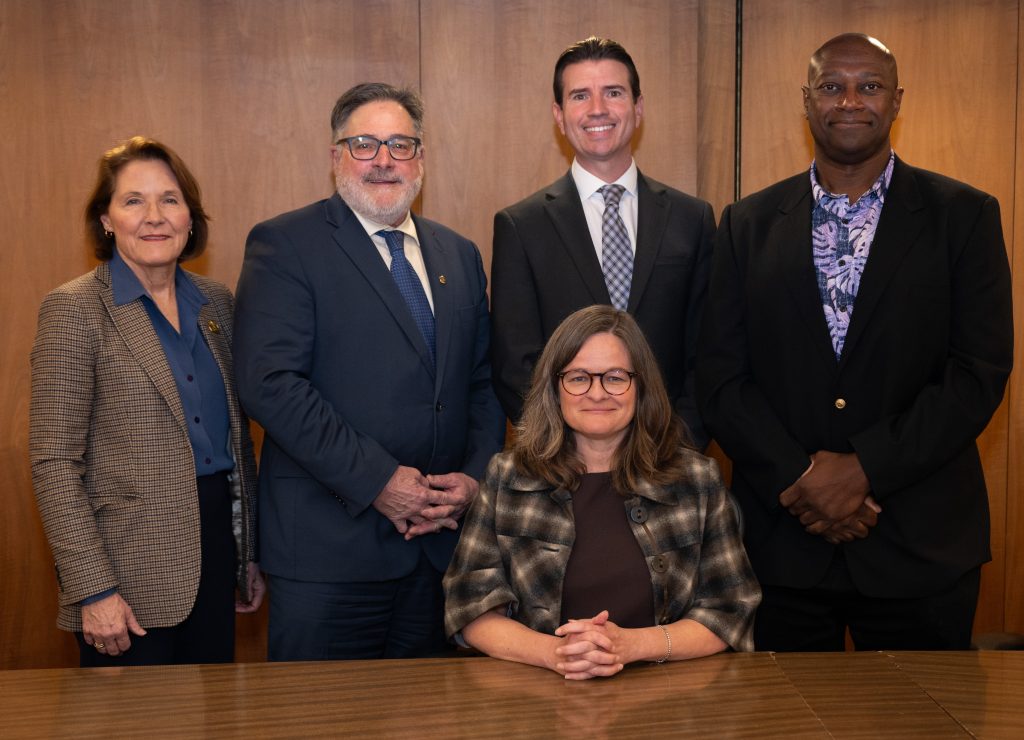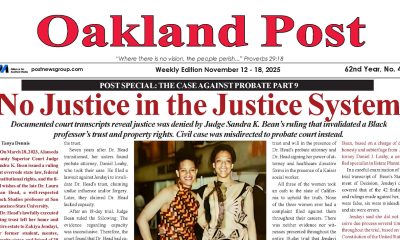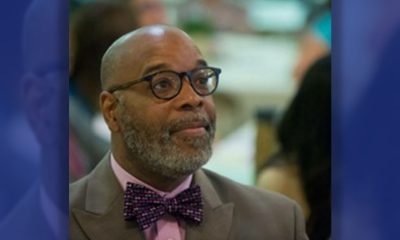Marin County
Kerner Report Set Standard for What a Serious Presidential Candidate Should Champion
As the Democratic presidential primaries move onto Nevada, South Carolina and the many Super Tuesday states, candidates turn their attention to people of color, and particularly African Americans.
Many candidates find their rhetoric contradicted by their record; their promises conflicting with their performances.
Donald Trump now seeks to woo Black voters by taking credit for the economy, by touting the first steps in reducing mass incarceration, and by hyping so-called “opportunity zones.”
His history—rising to prominence with the vile racist campaign about whether Barack Obama is American, embracing the Nazis at Charlottesville, dedicating his administration to erasing all things Obama, framing his political appeal on race-bait politics—gives the lie to his histrionics.
The same occurs on the Democratic side.
Pete Buttigieg always sounds good, but African American leaders in his town excoriate his record as mayor on race and policing. Amy Klobuchar runs as a moderate, but her brutal record as a prosecutor limits her appeal. Mike Bloomberg has the resources to flood the zone, but he too struggles to explain his harsh, racially-biased stop-and-frisk policies as mayor of New York or his laughable embrace of right-wing nutcase theories that somehow anti-redlining policies triggered the financial crisis.
Bloomberg is joined by Joe Biden on what seems like an endless apology tour.
African American voters are not easily fooled. They have a clear agenda. They suffer structural inequality—more unemployment than whites, lower wages, worse jobs, worse schools, inadequate health care, unaffordable housing, unsafe neighborhoods befouled by pollution and poisons, inadequate childcare, lack of recreational facilities, and the outrages of a criminal justice system that is structurally biased against them. They want what most Americans want, and they have a trained eye about politicians.
Notably absent from the debate is a leader prepared to be as bold and as serious about the challenges facing African Americans as the Kerner Commission was 22 years ago. The commission, chaired by Illinois Gov. Otto Kerner, was created by President Lyndon Johnson in the wake of the devastating urban riots of the late ‘60s. It included leaders from both major parties, as well as representatives of labor, the police, business and civil rights groups.
It became famous for its stark warning: “Our nation is moving toward two societies, one black, one white—separate and unequal.”
Dr. Martin Luther King pronounced the report a “physician’s warning of approaching death, with a prescription for life.” In many ways, it was the last attempt to address honestly and seriously the structural inequalities that plague African Americans.
It told harsh truths: “What white Americans have never fully understood but what the Negro can never forget—is that white society is deeply implicated in the ghetto. White institutions created it, white institutions maintain it, and white society condones it.” It concluded that one main cause of the urban violence was white racism that left too many young African Americans without hope.
It offered not nostrums and pablum but a serious agenda to redress the maladies: new jobs, new housing, an end to de facto segregation, integration of schools, daycare for children, higher wages or income supplementation, greater services, and more diverse and sensitive police forces. It did not blink at the billions that this would cost, suggesting that the cost of not acting would be far greater.
The Kerner Report—and Johnson’s War on Poverty—was lost in the jungles of Vietnam.
The costs of that misbegotten war—in money, in lives and agony, and in political upheaval—torpedoed any serious effort to address our problems at home.
What the Kerner Report did leave was a marker: a measure of what it means to be serious in addressing the problems of our society.
Much has changed over the last half-century, yet too much is the same. Affirmative action has opened closed doors for some people of color. America is more diverse, yet still deeply divided. De facto residential segregation has been largely sustained. Inequality has grown more extreme. Schools are even more divided by class and race. Affordable housing is even less available. Structural racism still stains our criminal justice system.
So, as the politicians come campaigning for African American votes, they will get a hearing.
We appreciate the attention and gestures. But the Kerner Report set the standard for what a serious leader would champion.
We’ll see who comes close, if anyone does, to accepting that challenge.
Activism
Marin Civic Center Library Marks Black History Month with 3 Events
The Civic Center Library’s Afternoon Book Club will celebrate and commemorate Black History and will meet in person on Thursday, Feb. 20 from 1-2 p.m. to discuss “The Nickel Boys” by Colson Whitehead. (This afternoon book club generally meets on the 3rd Thursday of every month from 1:00 p.m. to 2:00 p.m.)

By Godfrey Lee
The Marin County Civic Center Library in San Rafael will be celebrating Black History Month with presentations by Fauna Solomon on the steelpan drum, Keenan D. Webster on West African music and a book club discussion on “The Nickel Boys” by Colson Whitehead.
The library is located at 3501 Civic Center Dr., Room 427, in San Rafael, CA. 94903. Their phone number is (415) 473-6057.
Solomon will be sharing about the history and sounds of the steelpan drum on Friday, Feb. 14, from 12- 12:45 p.m. at the Civic Center Library.
Solomon is a former teacher and professional musician from Guyana, South America, and uses storytelling and performance to explore the complex and dynamic history of the instrument. Having played since age 5, Fauna has performed across the country. Her program traces the steelpan’s evolution from the West Indies to its global recognition, offering insight into its cultural and historical significance.
The Civic Center Library’s Afternoon Book Club will celebrate and commemorate Black History. It will meet in person on Thursday, Feb. 20 from 1-2 p.m. to discuss “The Nickel Boys” by Colson Whitehead. (This afternoon book club generally meets on the 3rd Thursday of every month from 1:00 p.m. to 2:00 p.m.)
A copy of the book can be requested online, or ask at the Info Desk of the Civic Center Library (or call 415-473-6057) for assistance in placing a hold.
“The Nickel Boys” is the story of two boys unjustly sentenced to a hellish reform school in Jim Crow-era Florida and is based on the real story of the Nickel Academy, a reform school that operated for 111 years and warped the lives of thousands of children.
When Elwood Curtis, a Black boy growing up in 1960s Tallahassee, is unfairly sentenced to the Nickel Academy, he finds himself trapped in a grotesque chamber of horrors. Elwood’s only salvation is his friendship with fellow “delinquent” Turner, which deepens despite Turner’s conviction that Elwood is hopelessly naive, that the world is crooked, and that the only way to survive is to scheme and avoid trouble. As life at the academy becomes ever more perilous, the tension between Elwood’s ideals and Turner’s skepticism leads to a decision whose repercussions will echo down the decades.
Later in the afternoon at the Civic Center Library, local musician Keenan D. Webster will be sharing about the traditional instruments of the Mandinka and the Mande-speaking people of West Africa on from 4-5 p.m. on Feb. 20.
Experience the Kora (West African Mandinka harp), the Kamele Ngoni (West African Mande harp), the Balaphone (Mandinka xylophone), and more. Feel the beauty, fire, and energy of this incredible music, and learn how these traditions gave birth to the banjo and influenced blues, jazz, and popular music of today.
Webster was born in Nashville, Tennessee. His love for the blues, spirituals, and gospel and folk music of the South deepened in his youth. As a teenager in Los Angeles, California, he became fascinated with African, Afro-Cuban, reggae, and other music from the African diaspora, and was further inspired to learn about his roots, music, culture and spirituality with the Gullah, Mandinka, Mende and Yoruba people of West Africa.
He started with drums of West Africa and Afro-Cuban roots. Then came jazz and Blues, playing the saxophone and flute, and later the Native American flute. He has a deep appreciation for world music and has familiarized himself with classical music from India, the Middle East, and Southeast Asia. Webster has been on a mission to use music for world peace, healing, to fight against racism, and to bring all people together.
Activism
Andre Thierry Explores Zydeco Music at Marin City Library
Grammy-nominated Andre Thierry leads the musical program with an interactive, engaging experience that combines traditional and newly composed music.

By Godfrey Lee
The “Are You Ready to Learn” music program allows children, families, and adults, to explore the rich Kreole culture and Zydeco music of southwestern Louisiana.
Grammy-nominated Andre Thierry leads the musical program with an interactive, engaging experience that combines traditional and newly composed music.
The program, created by Thierry, showcases a mix of African and Native American Blues and French Kreole dance melodies with elements of Afro-Caribbean music.
Children and families sing and dance while learning about popular Zydeco instruments like vest rub boards, drums, and accordion.
For information on the program, go to https://www.andrethierry.com
The free program will take place on Sunday, Feb. 9, at 1 p.m., at the Marin City Library, 164 Donahue St., in Marin City. For more information, call 415-332-6158.
Thierry will be performing again the Fairfax Library, 2097 Sir Francis Drake Blvd., Fairfax, on Saturday, Feb. 15, at 11 a.m. For more information, call 415-453-8092.
Alameda County
Brian Colbert Sworn in as Marin County’s First Black Supervisor
A 10-year San Anselmo resident, Former San Anselmo Mayor Brian Colbert was raised in Connecticut and has degrees from Oberlin (Ohio) College and the University of Chicago Law School. He worked on Wall Street, with several tech startups, and for a concierge medical practice in San Francisco. He was elected to the San Anselmo Town Council in 2017, was reelected in 2020, and served twice as mayor.

By Oakland Post Staff
Former San Anselmo Mayor Brian Colbert officially joined the Marin County Board of Supervisors on Jan. 14 as the District 2 representative. Colbert’s swearing-in was a celebratory event at the Marin County Civic Center that coincided with the swearing in of District 3 Supervisor Stephanie Moulton-Peters for a second term. District 1 Supervisor Mary Sackett, who has been selected as Board President, took her oath of office that day.
Colbert was elected in November 2024 to replace retired District 2 Supervisor Katie Rice, who served in that role since 2011 and completed 20 years of service as a county employee.
Colbert now represents the entire Ross Valley area following seven years on the San Anselmo Town Council.
A 10-year San Anselmo resident, Colbert was raised in Connecticut and has degrees from Oberlin (Ohio) College and the University of Chicago Law School. He worked on Wall Street, with several tech startups, and for a concierge medical practice in San Francisco. He was elected to the San Anselmo Town Council in 2017, was reelected in 2020, and served twice as mayor.
“As your newly elected official, I am committed to working tirelessly for the people of Marin County,” Colbert said. “Our county’s unique and distinct character — its natural beauty, diverse communities, and innovative spirit — makes it a place like no other.”
Colbert continued, “I will approach every challenge through the prism of preserving these values, focusing on solutions that promote economic vitality, environmental stewardship, and resilience. My pledge is to listen to your concerns, act with integrity, and ensure that every voice is heard as we tackle the issues that matter most and building a brighter future where opportunity and compassion go hand in hand.”

The Marin County Board of Supervisors members are (from left, standing) District 3’s Stephanie Moulton-Peters, District 4’s Dennis Rodoni, District 5’s Eric Lucan, District 2’s Brian Colbert, and (seated) District 1’s Mary Sackett, who is serving as Board President for 2025.
The ceremony included Colbert taking his public oath of office, administered by his daughter. There were also celebratory elements such as a performance by gospel singers from his district.
Supervisor Colbert’s swearing-in is a milestone for Marin County, as he is the first African American elected to the Board since its inception in 1852.
The Board typically meets two or three times a month on Tuesday mornings in the Board chamber of the Marin County Civic Center, Suite 330 in San Rafael. Meetings are conducted both in person at the chamber and also via videoconference to increase public engagement opportunities.
Meeting start times are usually 9 AM. All Board meetings are televised live on channel 27 for Marin County subscribers of Comcast/Xfinity and streamed live on MarinCounty.gov. Videos and agendas of the meetings dating to 2005 are archived on the website as well.
“We have a collaborative Board of Supervisors that is grounded in finding solutions for the good of our constituents, the County overall, and the health of our planet,” Sackett said during her opening remarks Tuesday. “I am focused on the County delivering essential services efficiently and effectively.”
-

 Activism3 weeks ago
Activism3 weeks agoOakland Post: Week of November 12 – 18, 2025
-

 Activism4 weeks ago
Activism4 weeks agoOakland Post: Week of November 5 – 11, 2025
-

 Activism2 weeks ago
Activism2 weeks agoIN MEMORIAM: William ‘Bill’ Patterson, 94
-

 Activism3 weeks ago
Activism3 weeks agoHow Charles R. Drew University Navigated More Than $20 Million in Fed Cuts – Still Prioritizing Students and Community Health
-

 #NNPA BlackPress3 weeks ago
#NNPA BlackPress3 weeks agoThe Perfumed Hand of Hypocrisy: Trump Hosted Former Terror Suspect While America Condemns a Muslim Mayor
-

 Bay Area3 weeks ago
Bay Area3 weeks agoNo Justice in the Justice System
-

 #NNPA BlackPress3 weeks ago
#NNPA BlackPress3 weeks agoProtecting Pedophiles: The GOP’s Warped Crusade Against Its Own Lies
-

 #NNPA BlackPress2 weeks ago
#NNPA BlackPress2 weeks agoTrump’s Death Threat Rhetoric Sends Nation into Crisis



























































